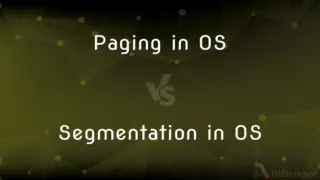Time Sharing Operating System vs. Real-Time Operating System — What's the Difference?
By Tayyaba Rehman — Published on January 15, 2024
Time Sharing Operating System (TSOS) allows multiple users to use a computer simultaneously; Real-Time Operating System (RTOS) ensures immediate processing of data for time-sensitive tasks.

Difference Between Time Sharing Operating System and Real-Time Operating System
Table of Contents
ADVERTISEMENT
Key Differences
Time Sharing Operating Systems (TSOS) are designed to provide multiple users access to computer resources concurrently. Real-Time Operating Systems (RTOS) prioritize processing data in real-time, focusing on meeting specific time constraints. TSOS optimizes for maximum task throughput, whereas RTOS emphasizes meeting time constraints for individual tasks.
In a TSOS, time is divided into small intervals, and resources are allocated to tasks in a way that users feel they have the system to themselves. An RTOS, in contrast, operates under strict timing constraints where the correctness of operation depends not only on the logical results but also on the time when these results are produced.
TSOS is commonly used in environments like shared servers and mainframes, where diverse tasks from multiple users are processed. RTOS is critical in systems where time predictability is essential, such as embedded systems in medical devices, automotive control systems, and robotics.
The scheduling in TSOS is generally more flexible and can be preemptive or non-preemptive. RTOS usually employs preemptive scheduling to ensure time-critical tasks are processed as required. TSOS aims to ensure fairness and efficiency, while RTOS's primary aim is to minimize response time for critical tasks.
Error handling in a TSOS is usually less rigorous compared to an RTOS. In an RTOS, timely and predictable error handling is crucial as it directly impacts the system's real-time performance. TSOS are built for general-purpose use, while RTOS are specialized for applications needing timely responses.
ADVERTISEMENT
Comparison Chart
Primary Objective
Maximizing user throughput
Meeting specific time constraints
Typical Use Cases
Shared servers, multi-user systems
Embedded systems, control systems
Scheduling
Flexible, fair resource allocation
Predictable, prioritizes time-critical tasks
Response Time
Efficient but not time-critical
Immediate and time-bound responses
Error Handling
Standard, general-purpose
Time-sensitive and critical
Compare with Definitions
Time Sharing Operating System
A system that manages the sharing of resources among multiple users.
Universities often use time sharing operating systems to allow students to access computational resources.
Real-Time Operating System
An OS designed for immediate task processing.
The real-time operating system in the robotic arm allowed for precise and immediate movements.
Time Sharing Operating System
An operating system designed for efficient multitasking.
Time sharing operating systems enable simultaneous data processing for various departments in a corporation.
Real-Time Operating System
An operating system with strict timing constraints.
Automotive control systems use real-time operating systems for immediate response.
Time Sharing Operating System
OS that allocates time slots for task execution.
The time sharing operating system ensured equitable CPU time for all running programs.
Real-Time Operating System
Software ensuring timely execution of critical tasks.
In industrial automation, real-time operating systems manage time-critical operations efficiently.
Time Sharing Operating System
A system that optimizes CPU usage among multiple users.
The time sharing operating system on the mainframe server handled hundreds of user requests per second.
Real-Time Operating System
System software that prioritizes time-sensitive tasks.
In critical medical equipment, a real-time operating system ensures timely data processing.
Time Sharing Operating System
Software that manages simultaneous access to a system.
Time sharing operating systems are essential in multi-user environments like research labs.
Real-Time Operating System
OS that focuses on predictable behavior.
Real-time operating systems are vital in aviation systems for predictable and safe operations.
Common Curiosities
What is the main function of a TSOS?
TSOS allows multiple users to access a computer's resources simultaneously.
Where is TSOS commonly used?
TSOS is typically used in multi-user environments like servers and mainframes.
What applications rely on RTOS?
RTOS is crucial in embedded systems, medical devices, and automotive controls.
What is a key feature of an RTOS?
RTOS provides immediate processing for time-sensitive tasks.
How does TSOS manage tasks?
TSOS divides CPU time into intervals to handle multiple tasks efficiently.
Can TSOS support interactive computing?
Yes, TSOS is well-suited for interactive computing environments.
Can TSOS handle real-time tasks?
While TSOS can process tasks efficiently, it's not designed for time-critical responses like RTOS.
What is the scheduling approach in RTOS?
RTOS often uses preemptive scheduling to prioritize critical tasks.
What is the priority in TSOS?
The priority in TSOS is maximizing throughput and fair resource distribution.
Is RTOS suitable for general-purpose computing?
RTOS is specialized for real-time applications, not general-purpose computing.
Is error handling different in RTOS compared to TSOS?
Yes, RTOS requires more rigorous and time-sensitive error handling.
What kind of user interface does RTOS typically have?
RTOS often has a minimal or specialized user interface due to its focused applications.
How do TSOS and RTOS differ in resource management?
TSOS aims for efficient utilization among many users, while RTOS focuses on immediate resource allocation for critical tasks.
What's a crucial aspect of RTOS?
Ensuring immediate and predictable responses to time-sensitive tasks is crucial in RTOS.
How does TSOS ensure fairness?
TSOS uses algorithms to allocate time slots equitably among users.
Share Your Discovery

Previous Comparison
Paging in OS vs. Segmentation in OS
Next Comparison
Primary Succession vs. Secondary SuccessionAuthor Spotlight
Written by
Tayyaba RehmanTayyaba Rehman is a distinguished writer, currently serving as a primary contributor to askdifference.com. As a researcher in semantics and etymology, Tayyaba's passion for the complexity of languages and their distinctions has found a perfect home on the platform. Tayyaba delves into the intricacies of language, distinguishing between commonly confused words and phrases, thereby providing clarity for readers worldwide.











































